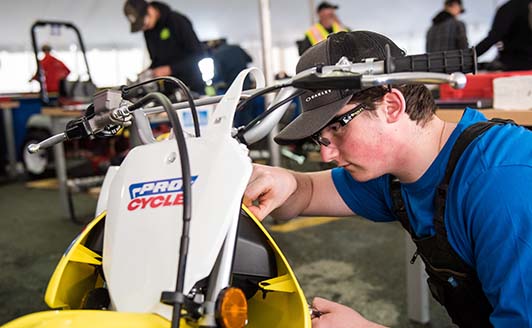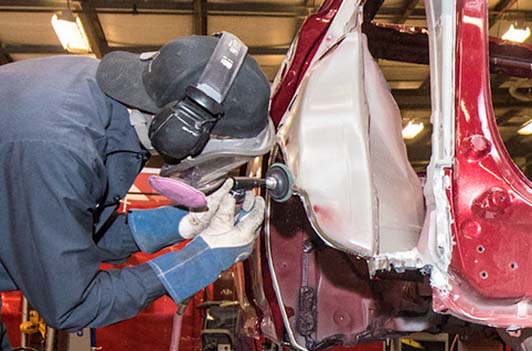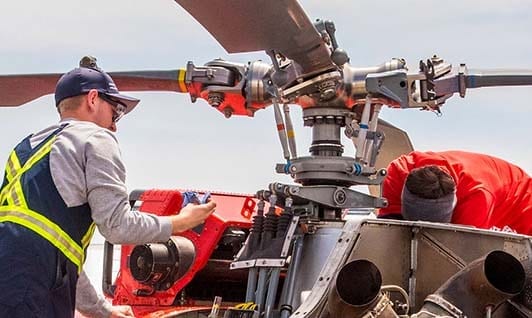Automobile Technology
What is automobile technology?
Automotive mechanics make mechanical repairs and carry out scheduled maintenance on cars, trucks and other motor vehicles using a variety of testing equipment and tools. This process customarily involves the use of computerized diagnostic equipment, such as infrared engine analyzers, spark plug testers and compression gauges. An even greater variety of tools is used to complete the work, including pneumatic wrenches, lathes and grinding machines, jacks and hoists, and electronic service equipment. Besides repairing damaged and defective vehicles, mechanics also conduct routine and scheduled maintenance: balancing and rotating tires, replacing filters, performing oil changes, lubrications and tune-ups, and installing parts such as mufflers, shock absorbers, exhaust pipes, radiators and springs. These repairs and maintenance must be completed to exacting safety standards.
With all of the complex repair and maintenance machinery used and the new technology built into modern automotive components, knowledge of electronics is increasingly desirable in a mechanic. In fact, the new developments in engines, transmissions and suspension systems, and the increased use of electronic components are changing the mechanic’s job into that of a technician, with more emphasis on vehicle diagnosis.
Automotive service technicians perform some or all of the following duties:
- Review work orders and discuss work with supervisor
- Inspect motor in operation, road test motor vehicle, and test automotive systems and components using computerized diagnostic and other testing devices to diagnose and isolate faults
- Adjust, repair or replace parts and components of automotive systems including fuel system, brakes, steering and suspension, engine and drive train, emission control and exhaust, cooling and climate control, and electrical and electronic systems using hand tools and other specialized automotive repair equipment
- Test and adjust repaired systems to manufacturer’s performance specifications
- Perform scheduled maintenance service, such as oil changes, lubrications and tune ups
- Advise customers on work performed, general vehicle condition and future repair requirements
HOW TO JOIN THE FIELD
Completion of secondary school is usually required.
Completion of a four-year automotive service technician apprenticeship program or a combination of over four years of work experience in the trade and high school, college or industry courses in automotive technology is required to be eligible for trade certification.
Automotive service technician trade certification is compulsory in Nova Scotia, Prince Edward Island, New Brunswick, Quebec, Ontario, Alberta and British Columbia and available, but voluntary, in all other provinces and the territories.
Automotive service technician (fuel, electrical and electronic systems) and automotive service technician (transmission) trade certification is compulsory in New Brunswick and Ontario and available, but voluntary, in Prince Edward Island.
Automotive service technician (steering, suspension and brakes) trade certification is compulsory in New Brunswick and Ontario.
Motor vehicle repair (service station mechanic) trade certification is compulsory in Nova Scotia and available, but voluntary, in Prince Edward Island.
Interprovincial trade certification (Red Seal) is also available to qualified automotive service technicians.
INDIGENOUS AND REMOTE CONSIDERATIONS
Many Indigenous and remote communities have mechanical knowledge, particularly when it comes to machines used to hunt. This enables people to fix machines in order to continue traditional hunting and gathering activities that sustain life. However, there may be less access to formal training on mechanical knowledge. Many fly-in communities do not have access to the types of equipment and workplace technology learn the ropes in this career. Students from these communities may need to relocate to get their education and training and may also need to travel to job sites once they get a career. However, mechanical knowledge is a highly desirable skill when it comes to life in remote communities where access to replacement parts and equipment is more limited than in other parts of the country.
Although most remote communities have a mechanic in town, some may not have all the tools and equipment to do the auto body work. This may mean that people who wish to pursue this career need to consider relocation for study and employment in this field.
DISABILITY CONSIDERATIONS
As this field involves manual skills and potentially uncomfortable working environments, it may be difficult for people with physical disabilities. Some accommodations may be necessary in order to be successful. It may also involve exposure to chemicals and strong smells, which may affect some people with disabilities.
Find the right career path for you with our interactive map!
Trouvez le cheminement de carrière qui vous convient grâce à notre carte interactive!
Sample Job Titles
- Heavy duty equipment mechanic
- Motor vehicle assembler
- Air conditioning mechanic
- Automotive mechanic
- Automotive service technician
- Motor repairer
- Transmission mechanic
Companies and Sectors
- Repair shops
- Car dealerships
- Industrial/manufacturing companies
- Self-employed

Automobile Technology and the Skills for Success Program
The top three essential skills for this career path are:
- Reading
- Digital
- Adaptability




